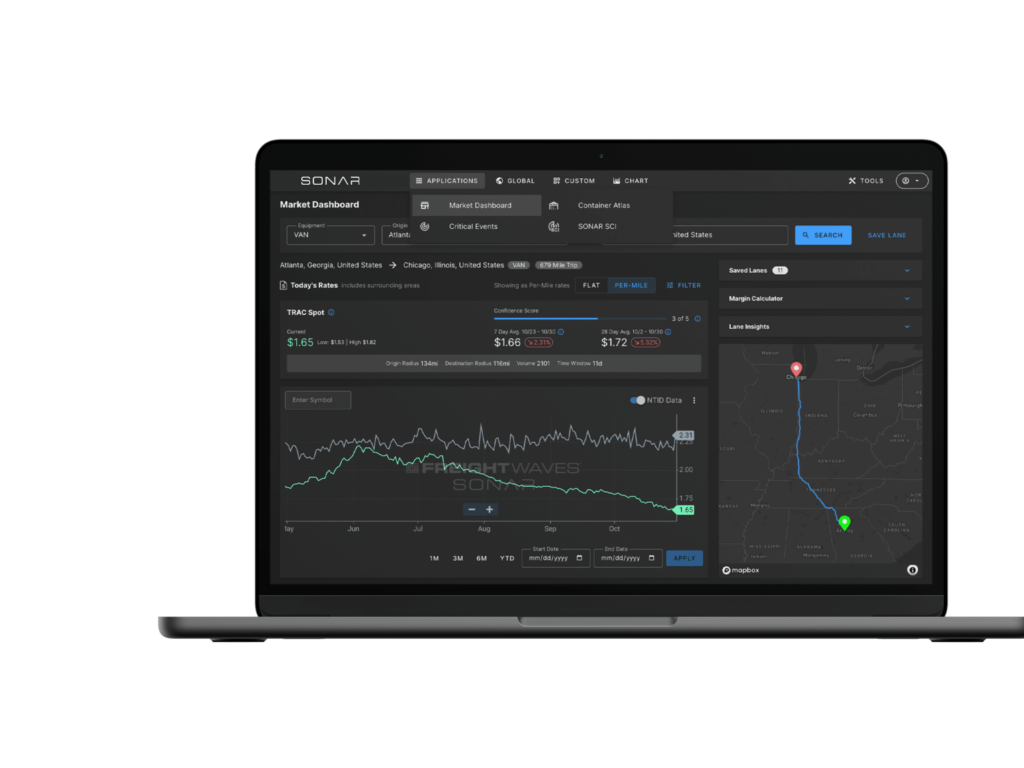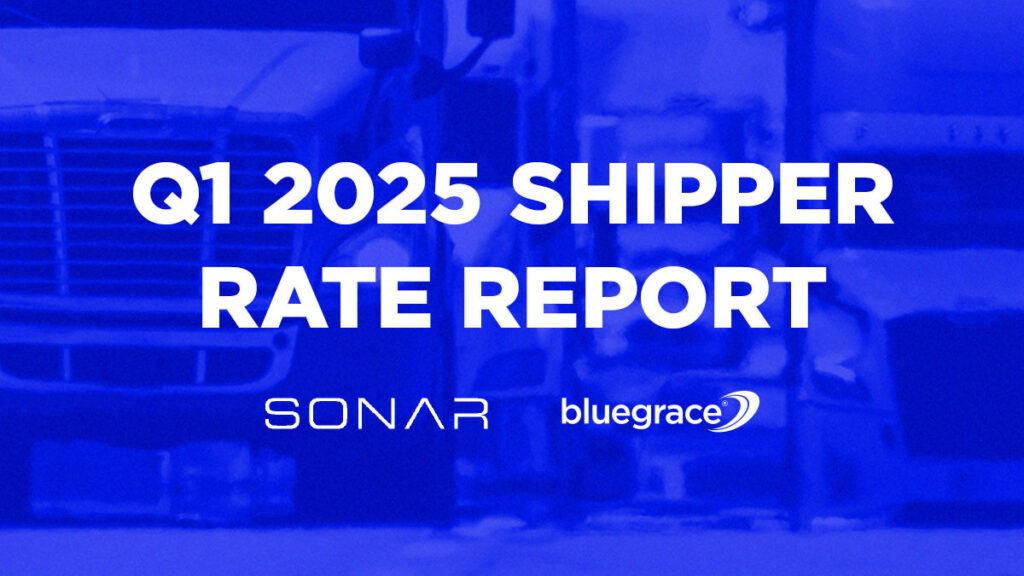Tender rejections and spot rates suggest freight market is improving.
This week’s SONAR Pricing Power Index (PPI): 35 (market favors shippers; unchanged from last week)
3-month SONAR Pricing Power Index Outlook: 40 (market favors shippers; unchanged from last week)
About the SONAR PPI: The SONAR Pricing Power Index is a qualitative assessment of the balance of negotiating power between shippers and carriers on a scale from 0 to 100 using SONAR data and anecdotes from discussions with SONAR clients. The higher the number, the tighter the freight market and the more that pricing power favors carriers. A “50” represents a balanced market. While the SONAR PPI primarily pertains to the truckload sector given its size, dynamics in other sectors, such as intermodal and ocean, are also considered.
Tender volume weakened in February, stabilized near month-end

2025 tender volume (white line) has shown weakness this month. (Chart: SONAR)
The bad news for carriers was that February tender volume, which measures the frequency of requests from shippers to move loads, weakened from January levels. That might call into question the thesis that the freight market is poised to tighten later this year. However, the main counterpoint is that February is the weakest seasonal month so it’s hard to get much of a read on the market. Plus, tender volume showed stabilization near month-end, essentially mirroring 2023 levels. March, a stronger seasonal month when bulky summer merchandise starts to move, will be more telling.
The Outbound Tender Volume Index (OTVI – shown above) is 8.9% below the year-ago level but is up 4.3% week over week, a similar pattern in late February to what we have seen the past two years. Dry van demand has been more volatile than reefer demand, which may reflect deteriorating consumer sentiment. The 8.9% year-over-year decline in overall tender volume breaks down to a 3.6% decline for the reefer segment and a more substantial 10.4% decline for dry van. The weakness in dry van volume can be partially attributed to market share gain by rail intermodal, as described below.
Tender rejection rates, spot rates reflect normal seasonal trends and a market that could still be poised to tighten

The national tender rejection rate is lower month over month but remains higher year over year. (Chart: SONAR)
The Outbound Tender Reject Index, a measure of relative tightness in truckload capacity, remains above year-ago levels despite tender volume that is below year-ago levels. The implication is that the capacity that has exited the market in the past year has been more impactful to the market than the decline in tender volume over the same period. That potentially sets the industry up for tightness during the stronger seasonal months.
The current overall tender rejection rate of 5.4% is down from a year-to-date peak of 8.3%. That decline in tender rejection rate may have happened in January rather than February without the numerous severe winter storms that temporarily removed capacity from the market. Weather events disrupt transportation networks every winter, but some events – like snow in New Orleans – were highly unusual. Highlighting differences between equipment types, the current dry van and reefer tender rejection rates are 5.1% and 10.1%, respectively. At just 1.9%, it’s notable how low the tender rejection rate is currently for outbound LA loads.

The trend in spot rates, adjusted for changes in fuel prices, suggests that February has experienced normal seasonality. Like tender rejection rates, they are higher, on average, year over year. (Chart: SONAR)
The SONAR National Truckload Index, an aggregate of spot rates with the impact of fuel removed, shows a decline in rates that is very consistent with the pattern of the past two years – declining throughout January and most of February before stabilizing. The fuel-adjusted spot rates shown in the chart above are flat week over week and 8.2% higher year over year.

Suggesting the freight market is improving, the spread between contract rates and spot rates has narrowed to within a range consistent with a relatively balanced freight market. The wider spread seen throughout most of 2022-2024 is associated with a very loose market. (Chart: SONAR)
Intermodal volume strong, but pricing remains muted

The one-year change in the SONAR Transcon Index of headhaul intermodal contract rates and the Local East Index of intermodal contract rates are shown in red and white, respectively. (Chart: SONAR)
A continuation of last year’s trend, intermodal volume started 2025 solid in both the international and domestic segments. In the past week, loaded containerized domestic intermodal volume is up 7.6% year over year, while loaded international intermodal volume is up 4.8% year over year against a more difficult year-ago comparison. Numerous factors have driven that volume growth, including solid consumer spending and record import volume, particularly at the U.S. West Coast ports, related to a pull-forward to avoid tariffs. (J.B. Hunt disputes this.) In addition, the availability of intermodal containers and solid rail service has supported intermodal volume. It’s clear from SONAR data that rail intermodal has taken share from truckload for outbound LA loads. That likely reflects a lower degree of time sensitivity for imports that were moved early.

Relative to last year and limiting data to outbound LA loads, international intermodal volume (white) and domestic intermodal volume (red) outperformed long-haul truckload tender volume (yellow) and dry van truckload tender volume (green). (Chart: SONAR)
Ocean market faces risks to the downside

In recent weeks, ocean spot rates have come down sharply from China to the U.S. West Coast (orange) and U.S. East Coast (white). (Chart: SONAR)
Ocean rates remain elevated relative to historical levels and relative to levels before the Red Sea attacks started in late 2023. But they have come down sharply in recent weeks and are near a 52-week low. As with the other freight sectors highlighted in the sections above, that may be due to seasonal factors. Supply appears to have returned following Chinese New Year while demand is still ramping up. As a result of the recent decline in spot rates, Flexport does not expect carriers to implement a general rate increase in March.
Looking ahead to later this year, there are more factors that could put downward pressure on ocean rates than factors that could do the opposite, as I argued in a recent article titled, Will ocean rates collapse? If the historically high ocean volume of the past few months really has been driven by a pull-forward ahead of tariffs, demand could be set to fall later in the year as that impact subsides. Meanwhile, the potential reopening of the Red Sea, and/or capacity created by shipbuilding, could increase supply to put downward pressure on rates. At the same time, the potential for port congestion, similar to what the industry saw last year at the Port of Singapore, or trade volume that exceeds expectations, or carriers closely managing capacity by blanking sailings, could support rates.











